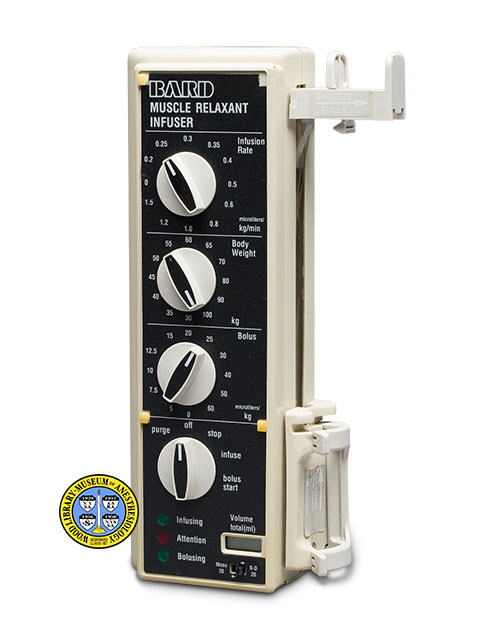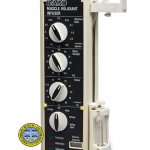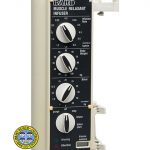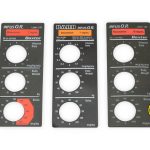Bard Muscle Relaxant Infuser
Apparatus for the infusion of medications were invented in the 19th Century. Neuromuscular blocking drugs have been used to keep the patient still during surgery since the 1940s. The medical supply company, C. R. Bard, made intravenous equipment in the 1980s. Bard's Muscle Relaxant Infuser was patented in 1990, and is nearly identical to the better-known Bard InfusOR, which was used primarily for patient-controlled analgesia. Bard sold its infusion division to Baxter International in 1990. Baxter continued making its own version of the InfusOR for a decade.
Both companies made magnetic panels that enabled their infusers to be used for the intravenous administration of several different drugs. Each panel fits over the dials on the face of the device, showing the correct concentrations for that agent. The settings included the infusion rate, the body weight of the patient, and the bolus (the amount contained in a single dose.) The infuser is shown here with a panel made by Bard for the muscle relaxant drug vecuronium bromide, as well as two panels made by Baxter for the muscle relaxants mivacurium chloride and rocuronium bromide.
Catalog Record: Bard Muscle Relaxant Infuser Bard Muscle Relaxant Infuser with Overlays
Access Key: aqsc
Accession No.: 1995-04-14-2 C
Title: Bard Muscle Relaxant Infuser / [Bard MedSystems Division].
Corporate Author: Bard MedSystems Division.
Publisher: North Reading, Massachusetts : Bard MedSystems Division, [between ca. 1985 and 1990].
Physical Description: 1 infuser : plastics, metals ; 23 x 12.5 x 6 cm.
Subject: Infusions, Intravenous – instrumentation.
Subject: Muscle Relaxants – administration and dosage.
Subject: Analgesia, Patient-Controlled – instrumentation.
Note Type: General
Notes: Bard had marketed several infusion devices by the mid-1980s; the first year in the range of possible dates of manufacture is based on this fact. The patent was filed in 1988. The second year in the date range is based on the year that Bard sold the division which made its infusion equipment.
Described from the perspective of the user, with the controls facing forward.
Note Type: Citation
Notes: C. R. Bard, Inc. Bard InfusOR Pump User’s Manual. North Reading, Massachusetts: Bard MedSystems Division, C. R. Bard, Inc., May 1989. http://gravepa.com/granaino/biblioteca/publicacionesmedicas/Medical%20Equipment%20Manuals/Bard%20InfusOR.pdf. Accessed March 5, 2018.
Note Type: Citation
Notes: Beemer GH. Continuous infusions of muscle relaxants – why and how. Anaesth Intens Care. February, 1987;15(1):83-89.
Note Type: Citation
Notes: drugwatch.com. https://www.drugwatch.com/manufacturer/bard/. Accessed March 26, 2018.
Note Type: Citation
Notes: Egan TD. Intravenous drug delivery devices and computer control. In: White PF, ed. Textbook of Intravenous Anesthesia. Baltimore: Williams & Wilkins, 1997:517-525.
Note Type: Citation
Notes: Fragen RJ. Drug Infusions in Anesthesiology. New York: Raven Press, 1991:28.
Note Type: Citation
Notes: Levine WC, Vernest KA. Infusion pumps. In: Ehrenwerth, Jan, James B. Eisenkraft, and James M. Berry. Anesthetic Equipment: Principles and Applications, 2nd ed. Philadelphia: Elsevier, 2013:377-382.
Note Type: Citation
Notes: Martineau RJ, St.-Jean B, Kitts JB, Curran MC, Lindsay P, Hull KA, Miller DR. Cumulation and reversal with prolonged infusions of atracurium and vecuronium. Can J Anaesth. August, 1992;39(7):670-676.
Note Type: Citation
Notes: Miller DR. Continuing medical education: intravenous infusion anaesthesia and delivery devices. Can J. Anaesth. July, 1994;41(7):639-652.
Note Type: Citation
Notes: Referenceforbusiness.com. www.referenceforbusiness.com/history2/91/C-R-Bard-Inc.html. Accessed December 22, 2017.
Note Type: Citation
Notes: Samiotes NG, Lucas P, inventors. C. R. Bard, Inc., assignee. Medical pump with infusion controlled by a detachable coded label. US Patent 4,943,379. July 24, 1990.
Note Type: Citation
Notes: Skakoon JG, Sleeman PS, inventors; C. R. Bard, Inc., assignee. Battery operated miniature syringe pump and improved halfnut therefor. US patent 4,804,368. February 14, 1989.
Note Type: Citation
Notes: Wikipedia website. https://en.wikipedia.org/wiki/Mivacurium_chloride (Accessed January 3, 2018).
Note Type: Citation
Notes: Wikipedia website. https://en.wikipedia.org/wiki/Rocuronium_bromide (Accessed January 3, 2018).
Note Type: Citation
Notes: Wikipedia website. https://en.wikipedia.org/wiki/Vecuronium_bromide (Accessed January 3, 2018).
Note Type: Physical Description
Notes: One infuser; The rectangular, putty-colored plastic housing is rounded on the left side; There are two extensions on the left side; That extension near the top of the apparatus holds a spring, and is marked: “SQUEEZE [new line] [right-facing arrow] [new line] FULLY”; That extension near the bottom of the apparatus holds a clip with two arms; This clip is marked “[left-facing arrow] [new line] PLACE SYRINGE [new line] BARREL FLANGE [new line] IN SLOT”; Between these extensions, there is a slot in the right side of the apparatus which is partially covered by strips of transparent plastic; The top and bottom of the apparatus are unmarked; The bottom has an opening on the left side that is covered by a sliding door or plate;
The front of the apparatus is marked, at the top: “BARD [new line] MUSCLE RELAXANT [new line] INFUSER”; Below this is a vertical row of four dials; From top to bottom, the first three dials are marked “Infusion Rate” , “Body Weight”, “Bolus”; That dial nearest the bottom of the apparatus is marked, from left to right: “purge, off, stop, infuse, bolus start”; Below the lowest dial there is a vertical row of three indicator lights; That light on the top is green and is marked “Infusion”; That light in the middle is red and is marked “Attention”; That light on the bottom is green and is marked: “Bolusing”; To the right of these lights is a digital readout window marked “Volume total (ml)”; Below this window is a switch marked, from left to right: “Mono 20”, and “B-D 20”.
Note Type: Reproduction
Notes: Photographed by Mr. Steve Donisch, January 15, 2018.
Note Type: Acquisition
Notes: Donated by Baxter Healthcare.
Note Type: Historical
Notes: In the 17th Century, opium became the first drug to be administered intravenously. More modern apparatus for the infusion of medications were invented in the 19th Century. The first patient-controlled analgesia (PCA) device was introduced in 1968. Muscle relaxant drugs have been used to keep the patient still during surgery since the 1940s. American importer Charles R. Bard expanded into the medical supply business in 1907. He went into partnership with inventor Morgan Parker in 1915, forming the sister company Bard-Parker. In 1923, Mr. Bard bought Mr. Parker’s shares and incorporated C. R. Bard.
By the mid-1980s, Bard’s MedSystems Division was making PCAs and other intravenous infusion equipment. The cataloged object is notably similar to the better-known Bard InfusOR. Bard filed to patent its InfusOR in 1986. That patent was granted in 1989; it is referenced in the 1989 Bard InfusOR user’s manual.
The cataloger found no information about the “Bard Muscle Relaxant Infuser”, but did find references in Fragen (1991) and Miller (1994, p. 647) to a “Bard Alfentanil Infuser”. (The opioid drug, alfentanil, was synthesized in 1976 and had been introduced by 1979.) In 1988, Bard filed to patent an apparatus apparently identical to the cataloged object; that patent was granted in 1990. Confusingly, Miller states that Bard developed the InfusOR “because of the limitations with the Alfentanil Infuser”.
In 1990, Bard sold its MedSystems Division to Baxter International. Baxter was founded in 1931 by partners Donald Baxter, M.D. and Ralph Falk, M.D. Its first products were intravenous pharmaceuticals and equipment. It is not known whether Baxter continued to use the Bard name after the 1990 acquisition, but it is unlikely. In the same year, it received a patent for the “Baxter InfusOR”. Baxter’s InfusOR appears identical to Bard’s. The corporate history given on Baxter’s website states that Baxter introduced “the InfusOR” in 1983.
Both companies made magnetic labels that enabled their infusers to be used for the intravenous administration of quite different classes of drugs. Each panel fits over the dials on the face of the device, showing the correct calibrations for that agent. The factors to be calibrated were the infusion rate, the body weight of the patient, and the bolus (the amount contained in a single dose). The WLM’s collection includes a panel made by Bard for the muscle relaxant drug vecuronium bromide (synthesized in 1964 and approved for medical use in 1984.) Also in the collection are panels made by Baxter for the muscle relaxants mivacurium chloride (synthesized in 1981 and introduced in 1984) and rocuronium bromide (introduced in 1994), as well as the opioid drug fentanyl (synthesized in 1959 and introduced in 1960.)
Note Type: Exhibition
Notes: Selected for the WLM website.
Access Key: aqsd
Accession No.: 2001-08-06-1 A
Title: [Bard InfusO.R. magnetic label for vecuronium] / Bard MedSystems Division]
Corporate Author: Bard MedSystems Division.
Title variation: Alt Title
Title: Bard InfusOR magnetic label for vecuronium.
Publisher: North Reading, Mass. : Bard MedSystems Division, [ca. 1985-1990].
Physical Description: 1 magnetic label : plastics, metals, 15 x 6 cm.
Subject: Infusions, Intravenous – instrumentation.
Subject: Muscle Relaxants – administration and dosage.
Subject: Mivacurium Chloride
Note Type: General
Notes: Bard had marketed several infusion devices by the mid-1980s; the first year in the range of possible dates of manufacture is based on this fact. The patent was filed in 1988. The second year in the date range is based on the year that Bard sold the division which made its infusion equipment.
Note Type: Citation
Notes: Wikipedia website. https://en.wikipedia.org/wiki/Vecuronium_bromide (Accessed January 3, 2018).
Note Type: Physical Description
Notes: One magnetic label; The front is marked near the top edge: “BARD INFUSO.R. [new line] Vecuronium 1 mg/mL”; Below this there is a vertical row of three round openings; From top to bottom, these are marked: “Infusion Rate”, “Body Weight” and “Bolus”;
The back is marked, in part: “Label: L04” and “Lot 15985001”.
Note Type: Reproduction
Notes: Photographed by Mr. Steve Donisch, January 15, 2018.
Note Type: Acquisition
Notes: Purchase.
Note Type: Exhibition
Notes: Selected for the WLM website.
Access Key: aqsf
Accession No.: 2010-09-21-1 C
Title: [Baxter InfusO.R. magnetic label for mivacurium] / Baxter Healthcare.
Corporate Author: Baxter Healthcare Corp.
Title variation: Alt Title
Title: Baxter InfusOR magnetic label for mivacurium.
Publisher: Deerfield, Illinois : Baxter Healthcare, [between 1990 and ca. 2000].
Physical Description: 1 magnetic label : plastics, metals, 15 x 6 cm.
Subject: Infusions, Intravenous – instrumentation.
Subject: Muscle Relaxants – administration and dosage.
Subject: Vecuronium Bromide.
Note Type: General
Notes: The first year in the range of possible dates of manufacture is based on the date that Baxter received a patent for the InfusOR. The second year in the date range is based on a literature search.
Note Type: Citation
Notes: Wikipedia website. https://en.wikipedia.org/wiki/Mivacurium_chloride (Accessed January 3, 2018).
Note Type: Physical Description
Notes: One magnetic label; The front is marked near the top edge: ” INFUSO.R. [new line] Label: L04 [new line] Rocuronium 10 mg/mL Baxter”; Below this there is a vertical row of three round openings; From top to bottom, these are marked: “Infusion Rate”, “Body Weight” and “Bolus”;
The back is marked, in part: “Lot 37419001”.
Note Type: Reproduction
Notes: Photographed by Mr. Steve Donisch, January 15, 2018.
Note Type: Acquisition
Notes: Donated by Hansjeog Hasche-Klunder, M.D.
Note Type: Exhibition
Notes: Selected for the WLM website.
Access Key: aqse
Accession No.: 2001-08-06-1 B
Title: [Baxter InfusO.R. magnetic label for rocuronium] / Baxter Healthcare.
Corporate Author: Baxter Healthcare Corp.
Title variation: Alt Title
Title: Baxter InfusOR magnetic label for rocuronium.
Publisher: Deerfield, Illinois : Baxter Healthcare, [between 1994 and ca. 2000].
Physical Description: 1 magnetic label : plastics, metals, 15 x 6 cm.
Subject: Infusions, Intravenous – instrumentation.
Subject: Muscle Relaxants – administration and dosage.
Subject: Rocuronium Bromide.
Note Type: General
Notes: The first year in the range of possible dates of manufacture is based on the date that the muscle relaxant drug rocuronium was clinically introduced. The second year in the date range is based on a literature search.
Note Type: Citation
Notes: Wikipedia website. https://en.wikipedia.org/wiki/Rocuronium_bromide (Accessed January 3, 2018).
Note Type: Physical Description
Notes: One magnetic label; The front is marked near the top edge: ” INFUSO.R. [new line] Label: L01 [new line] Mivacurium 2 mg/mL Baxter”; Below this there is a vertical row of three round openings; From top to bottom, these are marked: “Infusion Rate”, “Body Weight” and “Bolus”;
The back is marked, in part: “Lot 34982001”.
Note Type: Reproduction
Notes: Photographed by Mr. Steve Donisch, January 15, 2018.
Note Type: Acquisition
Notes: Purchase
Note Type: Exhibition
Notes: Selected for the WLM website.




